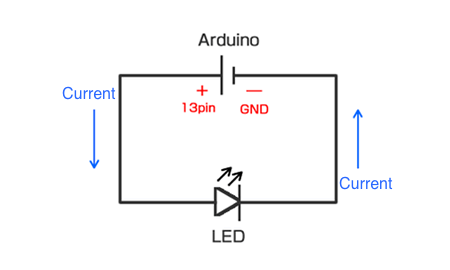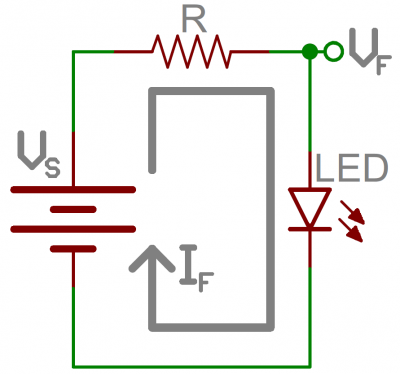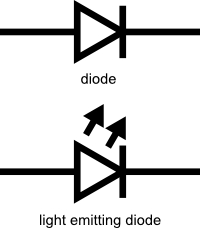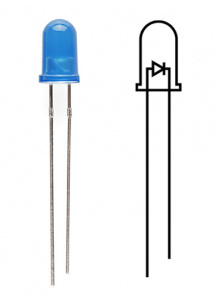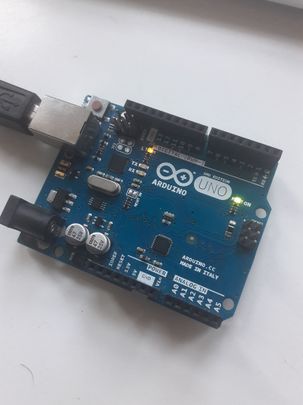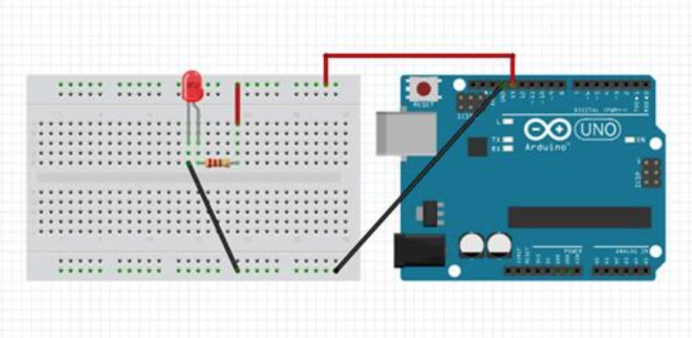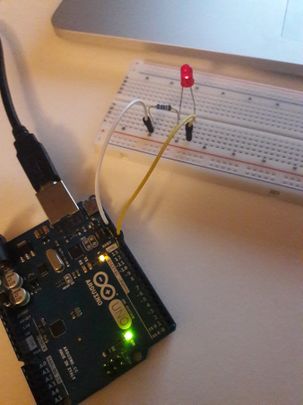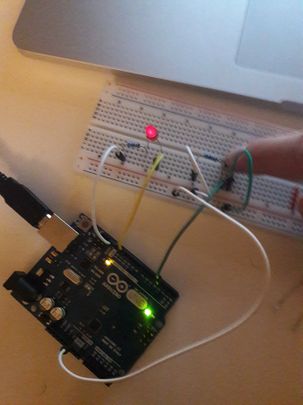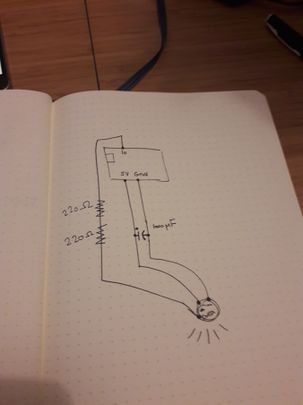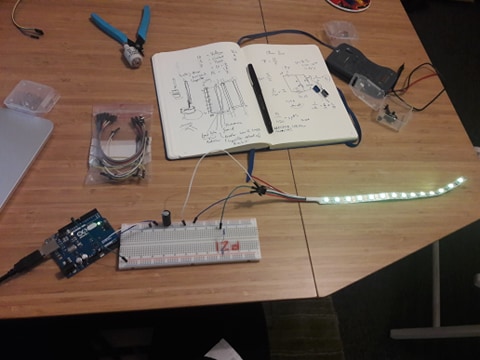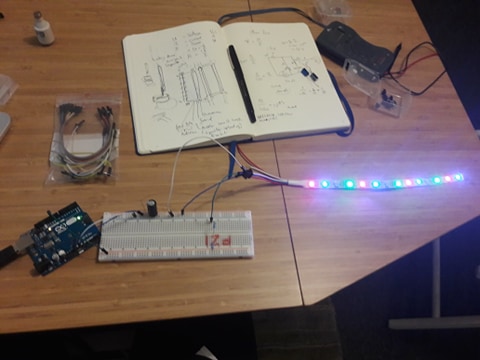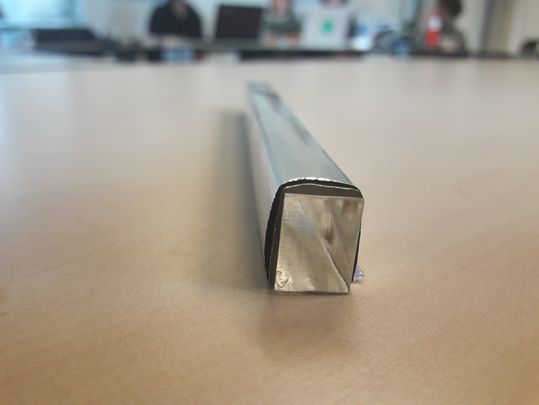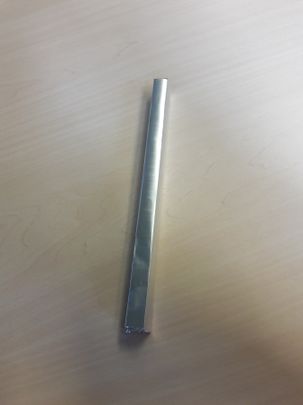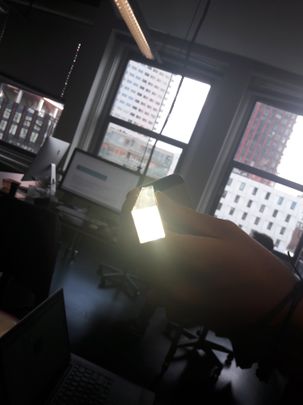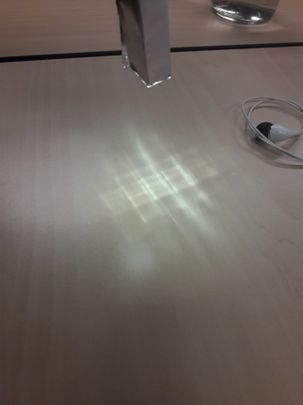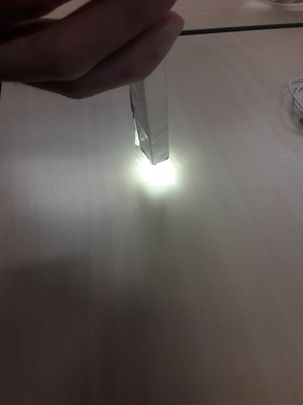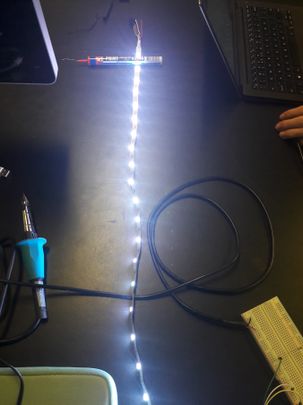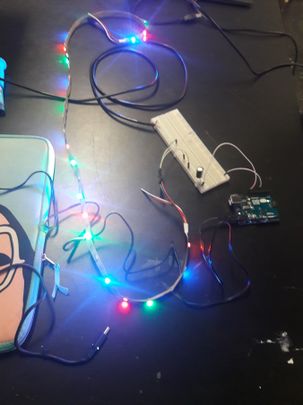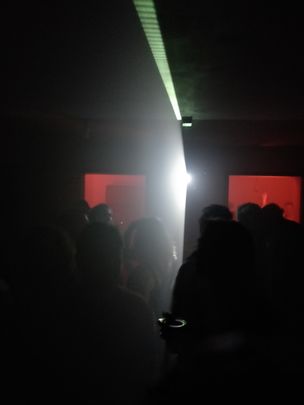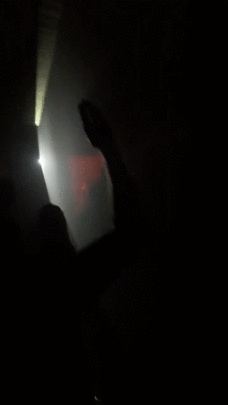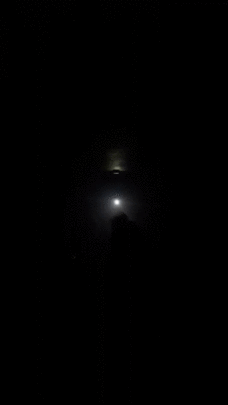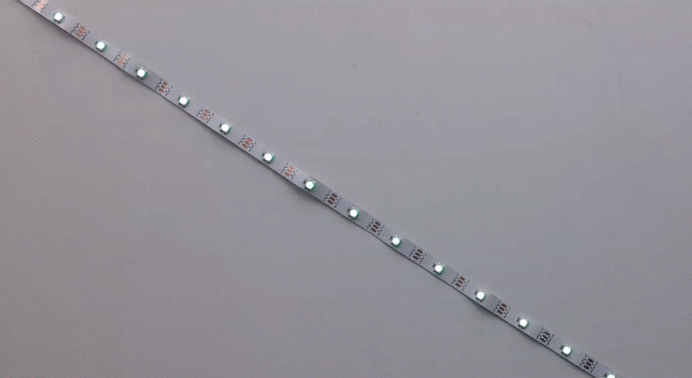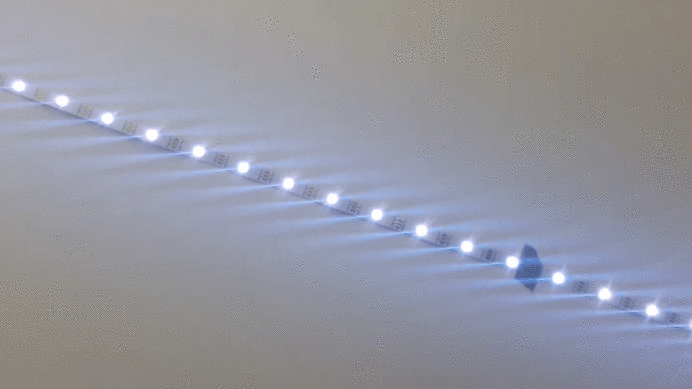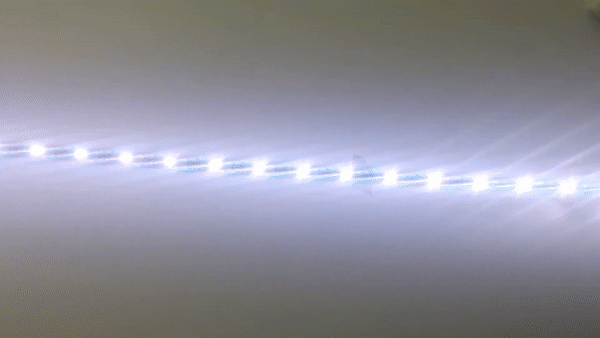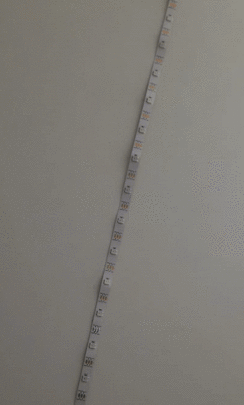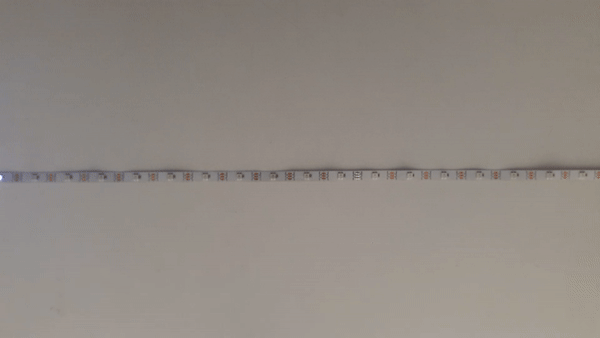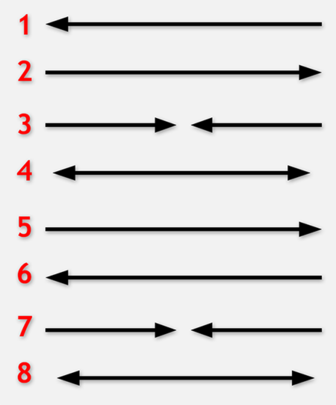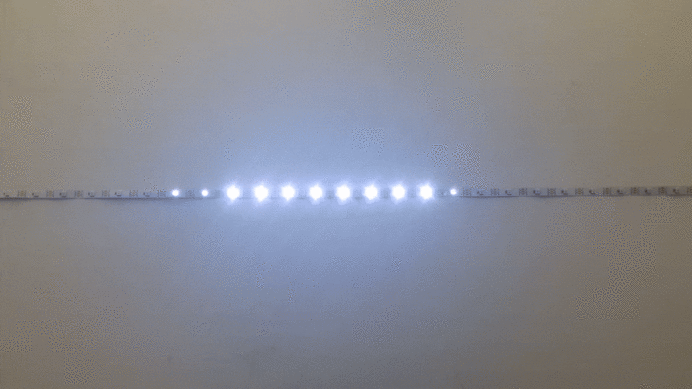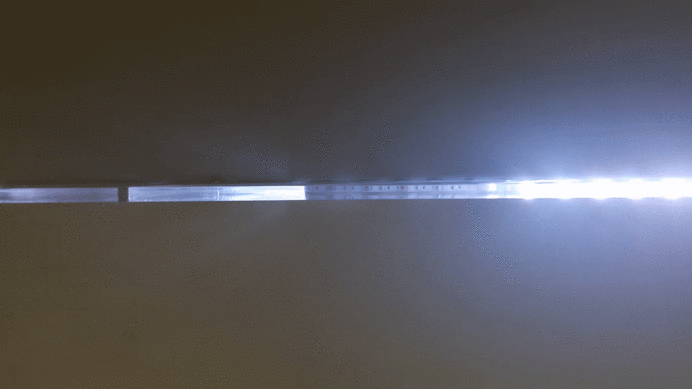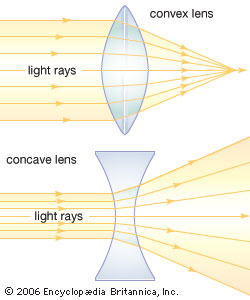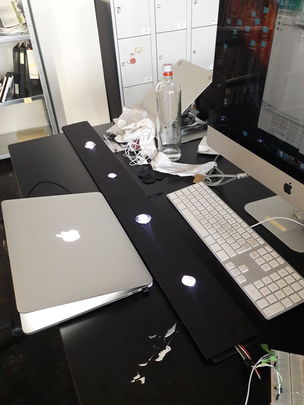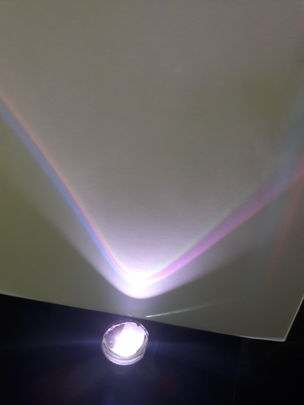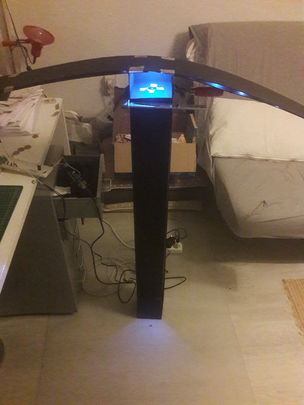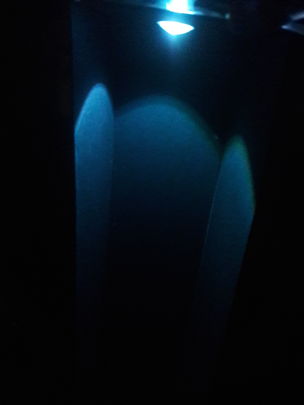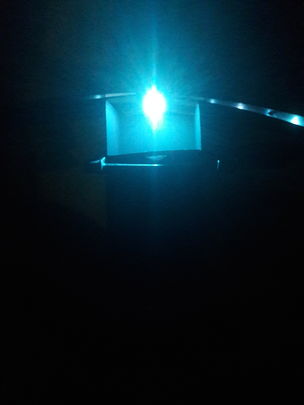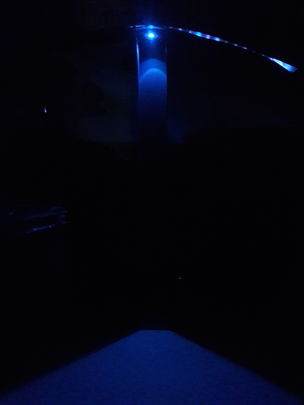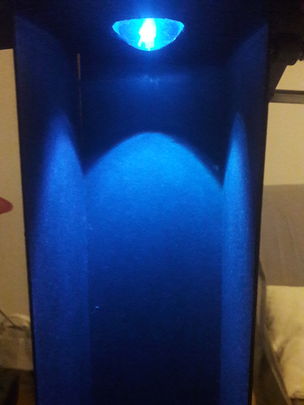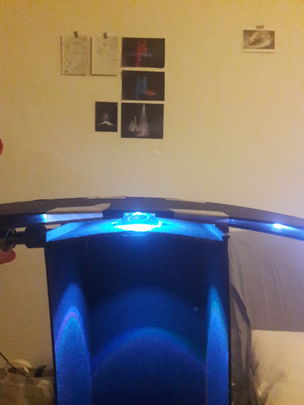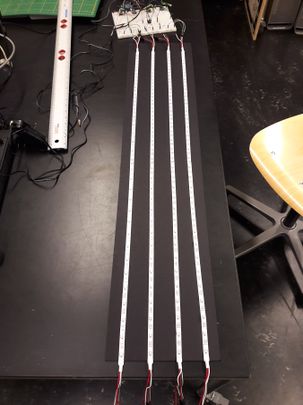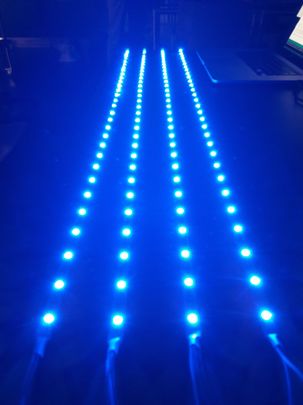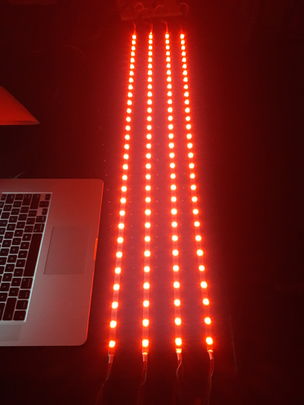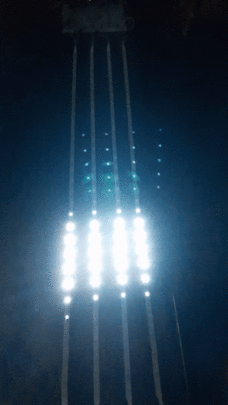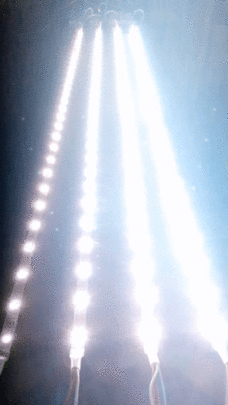User:Zalán Szakács/grad prototyping: Difference between revisions
No edit summary |
No edit summary |
||
| Line 1,202: | Line 1,202: | ||
<br> | <br> | ||
To be able to build an infrastructure of controlling 4 4 Adafruit Neopixel LED strips we needed to extend the breadboards and do some new wirering. | To be able to build an infrastructure of controlling 4 4 Adafruit Neopixel LED strips we needed to extend the breadboards and do some new wirering. | ||
<br> | |||
<gallery class="center" widths=692px heights=405px> | <gallery class="center" widths=692px heights=405px> | ||
File:46061339 2060726817299680 6145052762586480640 n (1).jpg|New setup | File:46061339 2060726817299680 6145052762586480640 n (1).jpg|New setup | ||
| Line 1,217: | Line 1,217: | ||
</gallery> | </gallery> | ||
<br> | <br> | ||
<pre> | |||
// NeoPixel Ring simple sketch (c) 2013 Shae Erisson | |||
// released under the GPLv3 license to match the rest of the AdaFruit NeoPixel library | |||
#include <Adafruit_NeoPixel.h> | |||
#ifdef __AVR__ | |||
#include <avr/power.h> | |||
#endif | |||
// Which pin on the Arduino is connected to the NeoPixels? | |||
// On a Trinket or Gemma we suggest changing this to 1 | |||
#define PIN_A 5 | |||
#define NUMPIXELS_A 30 | |||
#define PIN_B 6 | |||
#define NUMPIXELS_B 30 | |||
#define PIN_C 9 | |||
#define NUMPIXELS_C 30 | |||
#define PIN_D 10 | |||
#define NUMPIXELS_D 30 | |||
// When we setup the NeoPixel library, we tell it how many pixels, and which pin to use to send signals. | |||
// Note that for older NeoPixel strips you might need to change the third parameter--see the strandtest | |||
// example for more information on possible values. | |||
Adafruit_NeoPixel A = Adafruit_NeoPixel(NUMPIXELS_A, PIN_A, NEO_GRB + NEO_KHZ800); | |||
Adafruit_NeoPixel B = Adafruit_NeoPixel(NUMPIXELS_B, PIN_B, NEO_GRB + NEO_KHZ800); | |||
Adafruit_NeoPixel C = Adafruit_NeoPixel(NUMPIXELS_C, PIN_C, NEO_GRB + NEO_KHZ800); | |||
Adafruit_NeoPixel D = Adafruit_NeoPixel(NUMPIXELS_D, PIN_D, NEO_GRB + NEO_KHZ800); | |||
int delayval = 500; // delay for half a second | |||
void setup() { | |||
// This is for Trinket 5V 16MHz, you can remove these three lines if you are not using a Trinket | |||
#if defined (__AVR_ATtiny85__) | |||
if (F_CPU == 16000000) clock_prescale_set(clock_div_1); | |||
#endif | |||
// End of trinket special code | |||
A.begin(); // This initializes the NeoPixel library. | |||
B.begin(); // This initializes the NeoPixel library. | |||
C.begin(); // This initializes the NeoPixel library. | |||
D.begin(); // This initializes the NeoPixel library. | |||
} | |||
void loop() { | |||
// For a set of NeoPixels the first NeoPixel is 0, second is 1, all the way up to the count of pixels minus one. | |||
for(int i=0;i<NUMPIXELS_A;i++){ | |||
// pixels.Color takes RGB values, from 0,0,0 up to 255,255,255 | |||
A.setPixelColor(i, A.Color(0,255,255)); // Moderately bright green color. | |||
A.show(); // This sends the updated pixel color to the hardware. | |||
// pixels.Color takes RGB values, from 0,0,0 up to 255,255,255 | |||
B.setPixelColor(i, B.Color(0,255,255)); // Moderately bright green color. | |||
B.show(); // This sends the updated pixel color to the hardware. | |||
// pixels.Color takes RGB values, from 0,0,0 up to 255,255,255 | |||
C.setPixelColor(i, C.Color(0,255,255)); // Moderately bright green color. | |||
C.show(); // This sends the updated pixel color to the hardware. | |||
// pixels.Color takes RGB values, from 0,0,0 up to 255,255,255 | |||
D.setPixelColor(i, D.Color(0,255,255)); // Moderately bright green color. | |||
D.show(); // This sends the updated pixel color to the hardware. | |||
delay(delayval); // Delay for a period of time (in milliseconds). | |||
} | |||
} | |||
</pre> | |||
<gallery class="center" widths=692px heights=405px> | <gallery class="center" widths=692px heights=405px> | ||
| Line 1,227: | Line 1,303: | ||
</gallery> | </gallery> | ||
<br> | <br> | ||
<pre> | |||
#include <Adafruit_NeoPixel.h> | |||
#define PIN 8 | |||
#define NUM_LEDS 30 | |||
#define PIN_A 5 | |||
#define NUM_LEDS_A 30 | |||
#define PIN_B 6 | |||
#define NUM_LEDS_B 30 | |||
#define PIN_C 9 | |||
#define NUM_LEDS_C 30 | |||
#define PIN_D 10 | |||
#define NUM_LEDS_D 30 | |||
// Parameter 1 = number of pixels in strip | |||
// Parameter 2 = pin number (most are valid) | |||
// Parameter 3 = pixel type flags, add together as needed: | |||
// NEO_KHZ800 800 KHz bitstream (most NeoPixel products w/WS2812 LEDs) | |||
// NEO_KHZ400 400 KHz (classic 'v1' (not v2) FLORA pixels, WS2811 drivers) | |||
// NEO_GRB Pixels are wired for GRB bitstream (most NeoPixel products) | |||
// NEO_RGB Pixels are wired for RGB bitstream (v1 FLORA pixels, not v2) | |||
Adafruit_NeoPixel A = Adafruit_NeoPixel(NUM_LEDS_A, PIN_A, NEO_GRB + NEO_KHZ800); | |||
Adafruit_NeoPixel B = Adafruit_NeoPixel(NUM_LEDS_B, PIN_B, NEO_GRB + NEO_KHZ800); | |||
Adafruit_NeoPixel C = Adafruit_NeoPixel(NUM_LEDS_C, PIN_C, NEO_GRB + NEO_KHZ800); | |||
Adafruit_NeoPixel D = Adafruit_NeoPixel(NUM_LEDS_D, PIN_D, NEO_GRB + NEO_KHZ800); | |||
void setup() { | |||
A.begin(); | |||
A.show(); // Initialize all pixels to 'off' | |||
//B.begin(); | |||
//B.show(); // Initialize all pixels to 'off' | |||
//C.begin(); | |||
//C.show(); // Initialize all pixels to 'off' | |||
D.begin(); | |||
D.show(); // Initialize all pixels to 'off | |||
} | |||
void loop() { | |||
CylonBounce(0xff, 0xff, 0xff, 4, 150, 50); | |||
} | |||
void CylonBounce(byte red, byte green, byte blue, int EyeSize, int SpeedDelay, int ReturnDelay){ | |||
for(int i = 0; i < NUM_LEDS-EyeSize-2; i++) { | |||
setAll(0,0,0); | |||
setPixel(i, red/10, green/10, blue/10); | |||
for(int j = 1; j <= EyeSize; j++) { | |||
setPixel(i+j, red, green, blue); | |||
} | |||
setPixel(i+EyeSize+1, red/10, green/10, blue/10); | |||
showStrip(); | |||
delay(SpeedDelay); | |||
} | |||
delay(ReturnDelay); | |||
for(int i = NUM_LEDS-EyeSize-2; i > 0; i--) { | |||
setAll(0,0,0); | |||
setPixel(i, red/10, green/10, blue/10); | |||
for(int j = 1; j <= EyeSize; j++) { | |||
setPixel(i+j, red, green, blue); | |||
} | |||
setPixel(i+EyeSize+1, red/10, green/10, blue/10); | |||
showStrip(); | |||
delay(SpeedDelay); | |||
} | |||
delay(ReturnDelay); | |||
} | |||
void showStrip() { | |||
#ifdef ADAFRUIT_NEOPIXEL_H | |||
// NeoPixel | |||
A.show(); | |||
B.show(); | |||
C.show(); | |||
D.show(); | |||
#endif | |||
#ifndef ADAFRUIT_NEOPIXEL_H | |||
// FastLED | |||
FastLED.show(); | |||
#endif | |||
} | |||
void setPixel(int Pixel, byte red, byte green, byte blue) { | |||
#ifdef ADAFRUIT_NEOPIXEL_H | |||
// NeoPixel | |||
A.setPixelColor(Pixel, A.Color(red, green, blue)); | |||
B.setPixelColor(Pixel, A.Color(red, green, blue)); | |||
C.setPixelColor(Pixel, A.Color(red, green, blue)); | |||
D.setPixelColor(Pixel, A.Color(red, green, blue)); | |||
#endif | |||
#ifndef ADAFRUIT_NEOPIXEL_H | |||
// FastLED | |||
leds[Pixel].r = red; | |||
leds[Pixel].g = green; | |||
leds[Pixel].b = blue; | |||
#endif | |||
} | |||
void setAll(byte red, byte green, byte blue) { | |||
for(int i = 0; i < NUM_LEDS; i++ ) { | |||
setPixel(i, red, green, blue); | |||
} | |||
showStrip(); | |||
} | |||
</pre> | |||
<gallery class="center" widths=692px heights=405px> | <gallery class="center" widths=692px heights=405px> | ||
| Line 1,232: | Line 1,418: | ||
</gallery> | </gallery> | ||
<br> | <br> | ||
<pre> | |||
#include <Adafruit_NeoPixel.h> | |||
#define PIN 8 | |||
#define NUM_LEDS 30 | |||
#define PIN_A 5 | |||
#define NUM_LEDS_A 30 | |||
#define PIN_B 6 | |||
#define NUM_LEDS_B 30 | |||
#define PIN_C 9 | |||
#define NUM_LEDS_C 30 | |||
#define PIN_D 10 | |||
#define NUM_LEDS_D 30 | |||
// Parameter 1 = number of pixels in strip | |||
// Parameter 2 = pin number (most are valid) | |||
// Parameter 3 = pixel type flags, add together as needed: | |||
// NEO_KHZ800 800 KHz bitstream (most NeoPixel products w/WS2812 LEDs) | |||
// NEO_KHZ400 400 KHz (classic 'v1' (not v2) FLORA pixels, WS2811 drivers) | |||
// NEO_GRB Pixels are wired for GRB bitstream (most NeoPixel products) | |||
// NEO_RGB Pixels are wired for RGB bitstream (v1 FLORA pixels, not v2) | |||
Adafruit_NeoPixel A = Adafruit_NeoPixel(NUM_LEDS_A, PIN_A, NEO_GRB + NEO_KHZ800); | |||
Adafruit_NeoPixel B = Adafruit_NeoPixel(NUM_LEDS_B, PIN_B, NEO_GRB + NEO_KHZ800); | |||
Adafruit_NeoPixel C = Adafruit_NeoPixel(NUM_LEDS_C, PIN_C, NEO_GRB + NEO_KHZ800); | |||
Adafruit_NeoPixel D = Adafruit_NeoPixel(NUM_LEDS_D, PIN_D, NEO_GRB + NEO_KHZ800); | |||
void setup() { | |||
A.begin(); | |||
A.show(); // Initialize all pixels to 'off' | |||
B.begin(); | |||
B.show(); // Initialize all pixels to 'off' | |||
C.begin(); | |||
C.show(); // Initialize all pixels to 'off' | |||
D.begin(); | |||
D.show(); // Initialize all pixels to 'off' | |||
} | |||
void loop() { | |||
// Slower: | |||
// Strobe(0xff, 0x77, 0x00, 10, 100, 1000); | |||
// Fast: | |||
Strobe(0xff, 0xff, 0xff, 10, 1000, 1); | |||
} | |||
void Strobe(byte red, byte green, byte blue, int StrobeCount, int FlashDelay, int EndPause){ | |||
for(int j = 0; j < StrobeCount; j++) { | |||
setAll(red,green,blue); | |||
showStrip(); | |||
delay(FlashDelay); | |||
setAll(0,0,0); | |||
showStrip(); | |||
delay(FlashDelay); | |||
} | |||
delay(EndPause); | |||
} | |||
void showStrip() { | |||
#ifdef ADAFRUIT_NEOPIXEL_H | |||
// NeoPixel | |||
A.show(); | |||
B.show(); | |||
C.show(); | |||
D.show(); | |||
#endif | |||
#ifndef ADAFRUIT_NEOPIXEL_H | |||
// FastLED | |||
FastLED.show(); | |||
#endif | |||
} | |||
void setPixel(int Pixel, byte red, byte green, byte blue) { | |||
#ifdef ADAFRUIT_NEOPIXEL_H | |||
// NeoPixel | |||
A.setPixelColor(Pixel, A.Color(red, green, blue)); | |||
B.setPixelColor(Pixel, A.Color(red, green, blue)); | |||
C.setPixelColor(Pixel, A.Color(red, green, blue)); | |||
D.setPixelColor(Pixel, A.Color(red, green, blue)); | |||
#endif | |||
#ifndef ADAFRUIT_NEOPIXEL_H | |||
// FastLED | |||
leds[Pixel].r = red; | |||
leds[Pixel].g = green; | |||
leds[Pixel].b = blue; | |||
#endif | |||
} | |||
void setAll(byte red, byte green, byte blue) { | |||
for(int i = 0; i < NUM_LEDS; i++ ) { | |||
setPixel(i, red, green, blue); | |||
} | |||
showStrip(); | |||
} | |||
</pre> | |||
Revision as of 11:20, 14 November 2018
P R O T O T Y P I N G
What is a Circuit?
What are Resistors?
conversion calculator resistor color code
Light-Emitting Diodes (LEDs)
How to use Arduino?
1. Arduino Script
*
* Zalan's first Program
*/
int ledPin = 13;
void setup()
{
//initialize pins as outputs
pinMode(ledPin, OUTPUT);
}
void loop()
{
digitalWrite(ledPin, HIGH);
delay(1000);
digitalWrite(ledPin, LOW);
delay(1000);
}
2. Arduino Script
int LED = 12;
int BUTTON = 4;
void setup()
{
pinMode(LED,OUTPUT);
pinMode(BUTTON,INPUT);
}
void loop()
{
if(digitalRead(BUTTON) == HIGH)
{
digitalWrite(LED,HIGH);
}else
{
digitalWrite(LED,LOW);
}
}
3. Arduino Script
int switchPin = 8;
int ledPin = 13;
boolean lastButton = LOW;
boolean currentButton = LOW;
boolean ledOn = false;
void setup()
{
pinMode(switchPin, INPUT);
pinMode(ledPin, OUTPUT);
}
boolean debounce(boolean last)
{
boolean current = digitalRead(switchPin);
if (last != current)
{
delay(5);
current = digitalRead(switchPin);
}
return current;
}
void loop()
{
currentButton = debounce(lastButton);
if (lastButton == LOW && currentButton == HIGH)
{
ledOn -= !ledOn;
}
lastButton = currentButton;
digitalWrite(ledPin, ledOn);
}
4. Arduino Script
// NeoPixel Ring simple sketch (c) 2013 Shae Erisson
// released under the GPLv3 license to match the rest of the AdaFruit NeoPixel library
#include <Adafruit_NeoPixel.h>
#ifdef __AVR__
#include <avr/power.h>
#endif
// Which pin on the Arduino is connected to the NeoPixels?
// On a Trinket or Gemma we suggest changing this to 1
#define PIN 6
// How many NeoPixels are attached to the Arduino?
#define NUMPIXELS 16
// When we setup the NeoPixel library, we tell it how many pixels, and which pin to use to send signals.
// Note that for older NeoPixel strips you might need to change the third parameter--see the strandtest
// example for more information on possible values.
Adafruit_NeoPixel pixels = Adafruit_NeoPixel(NUMPIXELS, PIN, NEO_GRB + NEO_KHZ800);
int delayval = 500; // delay for half a second
void setup() {
// This is for Trinket 5V 16MHz, you can remove these three lines if you are not using a Trinket
#if defined (__AVR_ATtiny85__)
if (F_CPU == 16000000) clock_prescale_set(clock_div_1);
#endif
// End of trinket special code
pixels.begin(); // This initializes the NeoPixel library.
}
void loop() {
// For a set of NeoPixels the first NeoPixel is 0, second is 1, all the way up to the count of pixels minus one.
for(int i=0;i<NUMPIXELS;i++){
// pixels.Color takes RGB values, from 0,0,0 up to 255,255,255
pixels.setPixelColor(i, pixels.Color(0,150,0)); // Moderately bright green color.
pixels.show(); // This sends the updated pixel color to the hardware.
delay(delayval); // Delay for a period of time (in milliseconds).
}
}
5. Arduino Script
#include <Adafruit_NeoPixel.h>
#ifdef __AVR__
#include <avr/power.h>
#endif
#define PIN 10
#define NUM_LEDS 60
#define BRIGHTNESS 50
Adafruit_NeoPixel strip = Adafruit_NeoPixel(NUM_LEDS, PIN, NEO_GRBW + NEO_KHZ800);
byte neopix_gamma[] = {
0, 0, 0, 0, 0, 0, 0, 0, 0, 0, 0, 0, 0, 0, 0, 0,
0, 0, 0, 0, 0, 0, 0, 0, 0, 0, 0, 0, 1, 1, 1, 1,
1, 1, 1, 1, 1, 1, 1, 1, 1, 2, 2, 2, 2, 2, 2, 2,
2, 3, 3, 3, 3, 3, 3, 3, 4, 4, 4, 4, 4, 5, 5, 5,
5, 6, 6, 6, 6, 7, 7, 7, 7, 8, 8, 8, 9, 9, 9, 10,
10, 10, 11, 11, 11, 12, 12, 13, 13, 13, 14, 14, 15, 15, 16, 16,
17, 17, 18, 18, 19, 19, 20, 20, 21, 21, 22, 22, 23, 24, 24, 25,
25, 26, 27, 27, 28, 29, 29, 30, 31, 32, 32, 33, 34, 35, 35, 36,
37, 38, 39, 39, 40, 41, 42, 43, 44, 45, 46, 47, 48, 49, 50, 50,
51, 52, 54, 55, 56, 57, 58, 59, 60, 61, 62, 63, 64, 66, 67, 68,
69, 70, 72, 73, 74, 75, 77, 78, 79, 81, 82, 83, 85, 86, 87, 89,
90, 92, 93, 95, 96, 98, 99,101,102,104,105,107,109,110,112,114,
115,117,119,120,122,124,126,127,129,131,133,135,137,138,140,142,
144,146,148,150,152,154,156,158,160,162,164,167,169,171,173,175,
177,180,182,184,186,189,191,193,196,198,200,203,205,208,210,213,
215,218,220,223,225,228,231,233,236,239,241,244,247,249,252,255 };
void setup() {
// This is for Trinket 5V 16MHz, you can remove these three lines if you are not using a Trinket
#if defined (__AVR_ATtiny85__)
if (F_CPU == 16000000) clock_prescale_set(clock_div_1);
#endif
// End of trinket special code
strip.setBrightness(BRIGHTNESS);
strip.begin();
strip.show(); // Initialize all pixels to 'off'
}
void loop() {
// Some example procedures showing how to display to the pixels:
colorWipe(strip.Color(255, 0, 0), 50); // Red
colorWipe(strip.Color(0, 255, 0), 50); // Green
colorWipe(strip.Color(0, 0, 255), 50); // Blue
colorWipe(strip.Color(0, 0, 0, 255), 50); // White
whiteOverRainbow(20,75,5);
pulseWhite(5);
// fullWhite();
// delay(2000);
rainbowFade2White(3,3,1);
}
// Fill the dots one after the other with a color
void colorWipe(uint32_t c, uint8_t wait) {
for(uint16_t i=0; i<strip.numPixels(); i++) {
strip.setPixelColor(i, c);
strip.show();
delay(wait);
}
}
void pulseWhite(uint8_t wait) {
for(int j = 0; j < 256 ; j++){
for(uint16_t i=0; i<strip.numPixels(); i++) {
strip.setPixelColor(i, strip.Color(0,0,0, neopix_gamma[j] ) );
}
delay(wait);
strip.show();
}
for(int j = 255; j >= 0 ; j--){
for(uint16_t i=0; i<strip.numPixels(); i++) {
strip.setPixelColor(i, strip.Color(0,0,0, neopix_gamma[j] ) );
}
delay(wait);
strip.show();
}
}
void rainbowFade2White(uint8_t wait, int rainbowLoops, int whiteLoops) {
float fadeMax = 100.0;
int fadeVal = 0;
uint32_t wheelVal;
int redVal, greenVal, blueVal;
for(int k = 0 ; k < rainbowLoops ; k ++){
for(int j=0; j<256; j++) { // 5 cycles of all colors on wheel
for(int i=0; i< strip.numPixels(); i++) {
wheelVal = Wheel(((i * 256 / strip.numPixels()) + j) & 255);
redVal = red(wheelVal) * float(fadeVal/fadeMax);
greenVal = green(wheelVal) * float(fadeVal/fadeMax);
blueVal = blue(wheelVal) * float(fadeVal/fadeMax);
strip.setPixelColor( i, strip.Color( redVal, greenVal, blueVal ) );
}
//First loop, fade in!
if(k == 0 && fadeVal < fadeMax-1) {
fadeVal++;
}
//Last loop, fade out!
else if(k == rainbowLoops - 1 && j > 255 - fadeMax ){
fadeVal--;
}
strip.show();
delay(wait);
}
}
delay(500);
for(int k = 0 ; k < whiteLoops ; k ++){
for(int j = 0; j < 256 ; j++){
for(uint16_t i=0; i < strip.numPixels(); i++) {
strip.setPixelColor(i, strip.Color(0,0,0, neopix_gamma[j] ) );
}
strip.show();
}
delay(2000);
for(int j = 255; j >= 0 ; j--){
for(uint16_t i=0; i < strip.numPixels(); i++) {
strip.setPixelColor(i, strip.Color(0,0,0, neopix_gamma[j] ) );
}
strip.show();
}
}
delay(500);
}
void whiteOverRainbow(uint8_t wait, uint8_t whiteSpeed, uint8_t whiteLength ) {
if(whiteLength >= strip.numPixels()) whiteLength = strip.numPixels() - 1;
int head = whiteLength - 1;
int tail = 0;
int loops = 3;
int loopNum = 0;
static unsigned long lastTime = 0;
while(true){
for(int j=0; j<256; j++) {
for(uint16_t i=0; i<strip.numPixels(); i++) {
if((i >= tail && i <= head) || (tail > head && i >= tail) || (tail > head && i <= head) ){
strip.setPixelColor(i, strip.Color(0,0,0, 255 ) );
}
else{
strip.setPixelColor(i, Wheel(((i * 256 / strip.numPixels()) + j) & 255));
}
}
if(millis() - lastTime > whiteSpeed) {
head++;
tail++;
if(head == strip.numPixels()){
loopNum++;
}
lastTime = millis();
}
if(loopNum == loops) return;
head%=strip.numPixels();
tail%=strip.numPixels();
strip.show();
delay(wait);
}
}
}
void fullWhite() {
for(uint16_t i=0; i<strip.numPixels(); i++) {
strip.setPixelColor(i, strip.Color(0,0,0, 255 ) );
}
strip.show();
}
// Slightly different, this makes the rainbow equally distributed throughout
void rainbowCycle(uint8_t wait) {
uint16_t i, j;
for(j=0; j<256 * 5; j++) { // 5 cycles of all colors on wheel
for(i=0; i< strip.numPixels(); i++) {
strip.setPixelColor(i, Wheel(((i * 256 / strip.numPixels()) + j) & 255));
}
strip.show();
delay(wait);
}
}
void rainbow(uint8_t wait) {
uint16_t i, j;
for(j=0; j<256; j++) {
for(i=0; i<strip.numPixels(); i++) {
strip.setPixelColor(i, Wheel((i+j) & 255));
}
strip.show();
delay(wait);
}
}
// Input a value 0 to 255 to get a color value.
// The colours are a transition r - g - b - back to r.
uint32_t Wheel(byte WheelPos) {
WheelPos = 255 - WheelPos;
if(WheelPos < 85) {
return strip.Color(255 - WheelPos * 3, 0, WheelPos * 3,0);
}
if(WheelPos < 170) {
WheelPos -= 85;
return strip.Color(0, WheelPos * 3, 255 - WheelPos * 3,0);
}
WheelPos -= 170;
return strip.Color(WheelPos * 3, 255 - WheelPos * 3, 0,0);
}
uint8_t red(uint32_t c) {
return (c >> 16);
}
uint8_t green(uint32_t c) {
return (c >> 8);
}
uint8_t blue(uint32_t c) {
return (c);
}
Quick prototyping with Joca
Experiment question
How to make a stronger and more equal light beam of an LED light?'
Tools: Phone, aluminium foil, plexisheet 1 x 1 x 16 cm
Building new circuit together with Joca
19 | 10 | 18
Experimenting with light beam setup
23 | 10 | 18
components: 1 beamer, 1 smokemachine, 1 vault (dark room)
focus: How to divide the space with basic geometrical elements?
Adafruit NeoPixel Arduino experiment
05 | 11 | 18
Fade In and Fade Out: Red, Green and Blue
Facts:
- 1 m Adafruit NeoPixel
- 30 LEDs
#include <Adafruit_NeoPixel.h>
#define PIN 8
#define NUM_LEDS 30
// Parameter 1 = number of pixels in strip
// Parameter 2 = pin number (most are valid)
// Parameter 3 = pixel type flags, add together as needed:
// NEO_KHZ800 800 KHz bitstream (most NeoPixel products w/WS2812 LEDs)
// NEO_KHZ400 400 KHz (classic 'v1' (not v2) FLORA pixels, WS2811 drivers)
// NEO_GRB Pixels are wired for GRB bitstream (most NeoPixel products)
// NEO_RGB Pixels are wired for RGB bitstream (v1 FLORA pixels, not v2)
Adafruit_NeoPixel strip = Adafruit_NeoPixel(NUM_LEDS, PIN, NEO_GRB + NEO_KHZ800);
void setup() {
strip.begin();
strip.show(); // Initialize all pixels to 'off'
}
void loop() {
RGBLoop();
}
void RGBLoop(){
for(int j = 0; j < 3; j++ ) {
// Fade IN
for(int k = 0; k < 256; k++) {
switch(j) {
case 0: setAll(k,0,0); break;
case 1: setAll(0,k,0); break;
case 2: setAll(0,0,k); break;
}
showStrip();
delay(3);
}
// Fade OUT
for(int k = 255; k >= 0; k--) {
switch(j) {
case 0: setAll(k,0,0); break;
case 1: setAll(0,k,0); break;
case 2: setAll(0,0,k); break;
}
showStrip();
delay(3);
}
}
}
void showStrip() {
#ifdef ADAFRUIT_NEOPIXEL_H
// NeoPixel
strip.show();
#endif
#ifndef ADAFRUIT_NEOPIXEL_H
// FastLED
FastLED.show();
#endif
}
void setPixel(int Pixel, byte red, byte green, byte blue) {
#ifdef ADAFRUIT_NEOPIXEL_H
// NeoPixel
strip.setPixelColor(Pixel, strip.Color(red, green, blue));
#endif
#ifndef ADAFRUIT_NEOPIXEL_H
// FastLED
leds[Pixel].r = red;
leds[Pixel].g = green;
leds[Pixel].b = blue;
#endif
}
void setAll(byte red, byte green, byte blue) {
for(int i = 0; i < NUM_LEDS; i++ ) {
setPixel(i, red, green, blue);
}
showStrip();
}
Fade In and Fade Out: Custom colour
#include <Adafruit_NeoPixel.h>
#define PIN 8
#define NUM_LEDS 30
// Parameter 1 = number of pixels in strip
// Parameter 2 = pin number (most are valid)
// Parameter 3 = pixel type flags, add together as needed:
// NEO_KHZ800 800 KHz bitstream (most NeoPixel products w/WS2812 LEDs)
// NEO_KHZ400 400 KHz (classic 'v1' (not v2) FLORA pixels, WS2811 drivers)
// NEO_GRB Pixels are wired for GRB bitstream (most NeoPixel products)
// NEO_RGB Pixels are wired for RGB bitstream (v1 FLORA pixels, not v2)
Adafruit_NeoPixel strip = Adafruit_NeoPixel(NUM_LEDS, PIN, NEO_GRB + NEO_KHZ800);
void setup() {
strip.begin();
strip.show(); // Initialize all pixels to 'off'
}
void loop() {
FadeInOut(0xff, 0x77, 0x00);
}
void FadeInOut(byte red, byte green, byte blue){
float r, g, b;
for(int k = 0; k < 256; k=k+1) {
r = (k/256.0)*red;
g = (k/256.0)*green;
b = (k/256.0)*blue;
setAll(r,g,b);
showStrip();
}
for(int k = 255; k >= 0; k=k-2) {
r = (k/256.0)*red;
g = (k/256.0)*green;
b = (k/256.0)*blue;
setAll(r,g,b);
showStrip();
}
}
void showStrip() {
#ifdef ADAFRUIT_NEOPIXEL_H
// NeoPixel
strip.show();
#endif
#ifndef ADAFRUIT_NEOPIXEL_H
// FastLED
FastLED.show();
#endif
}
void setPixel(int Pixel, byte red, byte green, byte blue) {
#ifdef ADAFRUIT_NEOPIXEL_H
// NeoPixel
strip.setPixelColor(Pixel, strip.Color(red, green, blue));
#endif
#ifndef ADAFRUIT_NEOPIXEL_H
// FastLED
leds[Pixel].r = red;
leds[Pixel].g = green;
leds[Pixel].b = blue;
#endif
}
void setAll(byte red, byte green, byte blue) {
for(int i = 0; i < NUM_LEDS; i++ ) {
setPixel(i, red, green, blue);
}
showStrip();
}
Strobe
The function takes 6 parameters.
The first 3 are the same red, green and blue. In the example I used White.
The next parameter (StrobeCount) indicates how many flashes you’d like to see.
Parameters 5 (FlashDelay) and 6 (EndPause) are for delays between each individual flash and how long the function should wait once it completed all flashes.
#include <Adafruit_NeoPixel.h>
#define PIN 8
#define NUM_LEDS 30
// Parameter 1 = number of pixels in strip
// Parameter 2 = pin number (most are valid)
// Parameter 3 = pixel type flags, add together as needed:
// NEO_KHZ800 800 KHz bitstream (most NeoPixel products w/WS2812 LEDs)
// NEO_KHZ400 400 KHz (classic 'v1' (not v2) FLORA pixels, WS2811 drivers)
// NEO_GRB Pixels are wired for GRB bitstream (most NeoPixel products)
// NEO_RGB Pixels are wired for RGB bitstream (v1 FLORA pixels, not v2)
Adafruit_NeoPixel strip = Adafruit_NeoPixel(NUM_LEDS, PIN, NEO_GRB + NEO_KHZ800);
void setup() {
strip.begin();
strip.show(); // Initialize all pixels to 'off'
}
void loop() {
// Slower:
// Strobe(0xff, 0x77, 0x00, 10, 100, 1000);
// Fast:
Strobe(0xff, 0xff, 0xff, 10, 30, 1000);
}
void Strobe(byte red, byte green, byte blue, int StrobeCount, int FlashDelay, int EndPause){
for(int j = 0; j < StrobeCount; j++) {
setAll(red,green,blue);
showStrip();
delay(FlashDelay);
setAll(0,0,0);
showStrip();
delay(FlashDelay);
}
delay(EndPause);
}
void showStrip() {
#ifdef ADAFRUIT_NEOPIXEL_H
// NeoPixel
strip.show();
#endif
#ifndef ADAFRUIT_NEOPIXEL_H
// FastLED
FastLED.show();
#endif
}
void setPixel(int Pixel, byte red, byte green, byte blue) {
#ifdef ADAFRUIT_NEOPIXEL_H
// NeoPixel
strip.setPixelColor(Pixel, strip.Color(red, green, blue));
#endif
#ifndef ADAFRUIT_NEOPIXEL_H
// FastLED
leds[Pixel].r = red;
leds[Pixel].g = green;
leds[Pixel].b = blue;
#endif
}
void setAll(byte red, byte green, byte blue) {
for(int i = 0; i < NUM_LEDS; i++ ) {
setPixel(i, red, green, blue);
}
showStrip();
}
Cylon
The Cylon() function takes 6 parameters, where the first 3 are you preferred color. The 4th parameter (EyeSize) determines how many LEDs run around, or: the width of the “eye” (outer 2, faded, LEDs not counted).
The 5th parameter (SpeedDelay) influences how fast the eye moves, higher values means slow movement. The last parameter (ReturnDelay) sets how much time it should wait to bounce back.
#include <Adafruit_NeoPixel.h>
#define PIN 8
#define NUM_LEDS 30
// Parameter 1 = number of pixels in strip
// Parameter 2 = pin number (most are valid)
// Parameter 3 = pixel type flags, add together as needed:
// NEO_KHZ800 800 KHz bitstream (most NeoPixel products w/WS2812 LEDs)
// NEO_KHZ400 400 KHz (classic 'v1' (not v2) FLORA pixels, WS2811 drivers)
// NEO_GRB Pixels are wired for GRB bitstream (most NeoPixel products)
// NEO_RGB Pixels are wired for RGB bitstream (v1 FLORA pixels, not v2)
Adafruit_NeoPixel strip = Adafruit_NeoPixel(NUM_LEDS, PIN, NEO_GRB + NEO_KHZ800);
void setup() {
strip.begin();
strip.show(); // Initialize all pixels to 'off'
}
void loop() {
CylonBounce(0xff, 0xff, 0xff, 4, 10, 50);
}
void CylonBounce(byte red, byte green, byte blue, int EyeSize, int SpeedDelay, int ReturnDelay){
for(int i = 0; i < NUM_LEDS-EyeSize-2; i++) {
setAll(0,0,0);
setPixel(i, red/10, green/10, blue/10);
for(int j = 1; j <= EyeSize; j++) {
setPixel(i+j, red, green, blue);
}
setPixel(i+EyeSize+1, red/10, green/10, blue/10);
showStrip();
delay(SpeedDelay);
}
delay(ReturnDelay);
for(int i = NUM_LEDS-EyeSize-2; i > 0; i--) {
setAll(0,0,0);
setPixel(i, red/10, green/10, blue/10);
for(int j = 1; j <= EyeSize; j++) {
setPixel(i+j, red, green, blue);
}
setPixel(i+EyeSize+1, red/10, green/10, blue/10);
showStrip();
delay(SpeedDelay);
}
delay(ReturnDelay);
}
void showStrip() {
#ifdef ADAFRUIT_NEOPIXEL_H
// NeoPixel
strip.show();
#endif
#ifndef ADAFRUIT_NEOPIXEL_H
// FastLED
FastLED.show();
#endif
}
void setPixel(int Pixel, byte red, byte green, byte blue) {
#ifdef ADAFRUIT_NEOPIXEL_H
// NeoPixel
strip.setPixelColor(Pixel, strip.Color(red, green, blue));
#endif
#ifndef ADAFRUIT_NEOPIXEL_H
// FastLED
leds[Pixel].r = red;
leds[Pixel].g = green;
leds[Pixel].b = blue;
#endif
}
void setAll(byte red, byte green, byte blue) {
for(int i = 0; i < NUM_LEDS; i++ ) {
setPixel(i, red, green, blue);
}
showStrip();
}
KITT
Instead of bouncing back and forth it now follows this pattern:
#include <Adafruit_NeoPixel.h>
#define PIN 8
#define NUM_LEDS 30
// Parameter 1 = number of pixels in strip
// Parameter 2 = pin number (most are valid)
// Parameter 3 = pixel type flags, add together as needed:
// NEO_KHZ800 800 KHz bitstream (most NeoPixel products w/WS2812 LEDs)
// NEO_KHZ400 400 KHz (classic 'v1' (not v2) FLORA pixels, WS2811 drivers)
// NEO_GRB Pixels are wired for GRB bitstream (most NeoPixel products)
// NEO_RGB Pixels are wired for RGB bitstream (v1 FLORA pixels, not v2)
Adafruit_NeoPixel strip = Adafruit_NeoPixel(NUM_LEDS, PIN, NEO_GRB + NEO_KHZ800);
void setup() {
strip.begin();
strip.show(); // Initialize all pixels to 'off'
}
void loop() {
NewKITT(0xff, 0xff, 0xff, 8, 10, 50);
}
void NewKITT(byte red, byte green, byte blue, int EyeSize, int SpeedDelay, int ReturnDelay){
RightToLeft(red, green, blue, EyeSize, SpeedDelay, ReturnDelay);
LeftToRight(red, green, blue, EyeSize, SpeedDelay, ReturnDelay);
OutsideToCenter(red, green, blue, EyeSize, SpeedDelay, ReturnDelay);
CenterToOutside(red, green, blue, EyeSize, SpeedDelay, ReturnDelay);
LeftToRight(red, green, blue, EyeSize, SpeedDelay, ReturnDelay);
RightToLeft(red, green, blue, EyeSize, SpeedDelay, ReturnDelay);
OutsideToCenter(red, green, blue, EyeSize, SpeedDelay, ReturnDelay);
CenterToOutside(red, green, blue, EyeSize, SpeedDelay, ReturnDelay);
}
void CenterToOutside(byte red, byte green, byte blue, int EyeSize, int SpeedDelay, int ReturnDelay) {
for(int i =((NUM_LEDS-EyeSize)/2); i>=0; i--) {
setAll(0,0,0);
setPixel(i, red/10, green/10, blue/10);
for(int j = 1; j <= EyeSize; j++) {
setPixel(i+j, red, green, blue);
}
setPixel(i+EyeSize+1, red/10, green/10, blue/10);
setPixel(NUM_LEDS-i, red/10, green/10, blue/10);
for(int j = 1; j <= EyeSize; j++) {
setPixel(NUM_LEDS-i-j, red, green, blue);
}
setPixel(NUM_LEDS-i-EyeSize-1, red/10, green/10, blue/10);
showStrip();
delay(SpeedDelay);
}
delay(ReturnDelay);
}
void OutsideToCenter(byte red, byte green, byte blue, int EyeSize, int SpeedDelay, int ReturnDelay) {
for(int i = 0; i<=((NUM_LEDS-EyeSize)/2); i++) {
setAll(0,0,0);
setPixel(i, red/10, green/10, blue/10);
for(int j = 1; j <= EyeSize; j++) {
setPixel(i+j, red, green, blue);
}
setPixel(i+EyeSize+1, red/10, green/10, blue/10);
setPixel(NUM_LEDS-i, red/10, green/10, blue/10);
for(int j = 1; j <= EyeSize; j++) {
setPixel(NUM_LEDS-i-j, red, green, blue);
}
setPixel(NUM_LEDS-i-EyeSize-1, red/10, green/10, blue/10);
showStrip();
delay(SpeedDelay);
}
delay(ReturnDelay);
}
void LeftToRight(byte red, byte green, byte blue, int EyeSize, int SpeedDelay, int ReturnDelay) {
for(int i = 0; i < NUM_LEDS-EyeSize-2; i++) {
setAll(0,0,0);
setPixel(i, red/10, green/10, blue/10);
for(int j = 1; j <= EyeSize; j++) {
setPixel(i+j, red, green, blue);
}
setPixel(i+EyeSize+1, red/10, green/10, blue/10);
showStrip();
delay(SpeedDelay);
}
delay(ReturnDelay);
}
void RightToLeft(byte red, byte green, byte blue, int EyeSize, int SpeedDelay, int ReturnDelay) {
for(int i = NUM_LEDS-EyeSize-2; i > 0; i--) {
setAll(0,0,0);
setPixel(i, red/10, green/10, blue/10);
for(int j = 1; j <= EyeSize; j++) {
setPixel(i+j, red, green, blue);
}
setPixel(i+EyeSize+1, red/10, green/10, blue/10);
showStrip();
delay(SpeedDelay);
}
delay(ReturnDelay);
}
void showStrip() {
#ifdef ADAFRUIT_NEOPIXEL_H
// NeoPixel
strip.show();
#endif
#ifndef ADAFRUIT_NEOPIXEL_H
// FastLED
FastLED.show();
#endif
}
void setPixel(int Pixel, byte red, byte green, byte blue) {
#ifdef ADAFRUIT_NEOPIXEL_H
// NeoPixel
strip.setPixelColor(Pixel, strip.Color(red, green, blue));
#endif
#ifndef ADAFRUIT_NEOPIXEL_H
// FastLED
leds[Pixel].r = red;
leds[Pixel].g = green;
leds[Pixel].b = blue;
#endif
}
void setAll(byte red, byte green, byte blue) {
for(int i = 0; i < NUM_LEDS; i++ ) {
setPixel(i, red, green, blue);
}
showStrip();
}
KITT script with a plexiglass
For this experiment I placed an plexisheet on the LED strip to be able to create a stronger light beam
Experiments with Collimators & LEDs
09 | 11 | 18
Plano Convex Lens
Facts:
- 2x small Plano Convex Lenses
- 2x big Plano Convex Lenses
- ADAFRUIT NEOPIXEL 1m (30 LEDs) - 4 used
I was interested, how the different plano convex lenses would create different light beams.
Conclusion
The distance between the LED and the lens is very important. By varying the distance you can control the light beam and measure it to be able to calculate in the formula.
Experiments with the distance between the collimators & LEDs
10 | 11 | 18
Plano Convex Lens
Facts:
- 1x small Plano Convex Lenses
- 1x big Plano Convex Lenses
- ADAFRUIT NEOPIXEL 1m (30 LEDs) - 1 used
- custom build black cardboard box
I was interested, how the different plano convex lenses would create different light beams in different distances to LEDs. Therefor I needed to build a custom box (1mx10cmx10cm) to be able to catch the light beam. The plano convex lenses were attached to a cardboard surface (10cm x 10 cm) and they were free to move in different distance inside of the box.
Conclusion
Having only around 1 cm distance between the plano convex lens and the LED – the light beam is strongest.
Building a circuit for 4 Adafruit Neopixel LED strips with Joca
13 | 11 | 18
4 Adafruit Neopixel LED strips
To be able to build an infrastructure of controlling 4 4 Adafruit Neopixel LED strips we needed to extend the breadboards and do some new wirering.
// NeoPixel Ring simple sketch (c) 2013 Shae Erisson
// released under the GPLv3 license to match the rest of the AdaFruit NeoPixel library
#include <Adafruit_NeoPixel.h>
#ifdef __AVR__
#include <avr/power.h>
#endif
// Which pin on the Arduino is connected to the NeoPixels?
// On a Trinket or Gemma we suggest changing this to 1
#define PIN_A 5
#define NUMPIXELS_A 30
#define PIN_B 6
#define NUMPIXELS_B 30
#define PIN_C 9
#define NUMPIXELS_C 30
#define PIN_D 10
#define NUMPIXELS_D 30
// When we setup the NeoPixel library, we tell it how many pixels, and which pin to use to send signals.
// Note that for older NeoPixel strips you might need to change the third parameter--see the strandtest
// example for more information on possible values.
Adafruit_NeoPixel A = Adafruit_NeoPixel(NUMPIXELS_A, PIN_A, NEO_GRB + NEO_KHZ800);
Adafruit_NeoPixel B = Adafruit_NeoPixel(NUMPIXELS_B, PIN_B, NEO_GRB + NEO_KHZ800);
Adafruit_NeoPixel C = Adafruit_NeoPixel(NUMPIXELS_C, PIN_C, NEO_GRB + NEO_KHZ800);
Adafruit_NeoPixel D = Adafruit_NeoPixel(NUMPIXELS_D, PIN_D, NEO_GRB + NEO_KHZ800);
int delayval = 500; // delay for half a second
void setup() {
// This is for Trinket 5V 16MHz, you can remove these three lines if you are not using a Trinket
#if defined (__AVR_ATtiny85__)
if (F_CPU == 16000000) clock_prescale_set(clock_div_1);
#endif
// End of trinket special code
A.begin(); // This initializes the NeoPixel library.
B.begin(); // This initializes the NeoPixel library.
C.begin(); // This initializes the NeoPixel library.
D.begin(); // This initializes the NeoPixel library.
}
void loop() {
// For a set of NeoPixels the first NeoPixel is 0, second is 1, all the way up to the count of pixels minus one.
for(int i=0;i<NUMPIXELS_A;i++){
// pixels.Color takes RGB values, from 0,0,0 up to 255,255,255
A.setPixelColor(i, A.Color(0,255,255)); // Moderately bright green color.
A.show(); // This sends the updated pixel color to the hardware.
// pixels.Color takes RGB values, from 0,0,0 up to 255,255,255
B.setPixelColor(i, B.Color(0,255,255)); // Moderately bright green color.
B.show(); // This sends the updated pixel color to the hardware.
// pixels.Color takes RGB values, from 0,0,0 up to 255,255,255
C.setPixelColor(i, C.Color(0,255,255)); // Moderately bright green color.
C.show(); // This sends the updated pixel color to the hardware.
// pixels.Color takes RGB values, from 0,0,0 up to 255,255,255
D.setPixelColor(i, D.Color(0,255,255)); // Moderately bright green color.
D.show(); // This sends the updated pixel color to the hardware.
delay(delayval); // Delay for a period of time (in milliseconds).
}
}
#include <Adafruit_NeoPixel.h>
#define PIN 8
#define NUM_LEDS 30
#define PIN_A 5
#define NUM_LEDS_A 30
#define PIN_B 6
#define NUM_LEDS_B 30
#define PIN_C 9
#define NUM_LEDS_C 30
#define PIN_D 10
#define NUM_LEDS_D 30
// Parameter 1 = number of pixels in strip
// Parameter 2 = pin number (most are valid)
// Parameter 3 = pixel type flags, add together as needed:
// NEO_KHZ800 800 KHz bitstream (most NeoPixel products w/WS2812 LEDs)
// NEO_KHZ400 400 KHz (classic 'v1' (not v2) FLORA pixels, WS2811 drivers)
// NEO_GRB Pixels are wired for GRB bitstream (most NeoPixel products)
// NEO_RGB Pixels are wired for RGB bitstream (v1 FLORA pixels, not v2)
Adafruit_NeoPixel A = Adafruit_NeoPixel(NUM_LEDS_A, PIN_A, NEO_GRB + NEO_KHZ800);
Adafruit_NeoPixel B = Adafruit_NeoPixel(NUM_LEDS_B, PIN_B, NEO_GRB + NEO_KHZ800);
Adafruit_NeoPixel C = Adafruit_NeoPixel(NUM_LEDS_C, PIN_C, NEO_GRB + NEO_KHZ800);
Adafruit_NeoPixel D = Adafruit_NeoPixel(NUM_LEDS_D, PIN_D, NEO_GRB + NEO_KHZ800);
void setup() {
A.begin();
A.show(); // Initialize all pixels to 'off'
//B.begin();
//B.show(); // Initialize all pixels to 'off'
//C.begin();
//C.show(); // Initialize all pixels to 'off'
D.begin();
D.show(); // Initialize all pixels to 'off
}
void loop() {
CylonBounce(0xff, 0xff, 0xff, 4, 150, 50);
}
void CylonBounce(byte red, byte green, byte blue, int EyeSize, int SpeedDelay, int ReturnDelay){
for(int i = 0; i < NUM_LEDS-EyeSize-2; i++) {
setAll(0,0,0);
setPixel(i, red/10, green/10, blue/10);
for(int j = 1; j <= EyeSize; j++) {
setPixel(i+j, red, green, blue);
}
setPixel(i+EyeSize+1, red/10, green/10, blue/10);
showStrip();
delay(SpeedDelay);
}
delay(ReturnDelay);
for(int i = NUM_LEDS-EyeSize-2; i > 0; i--) {
setAll(0,0,0);
setPixel(i, red/10, green/10, blue/10);
for(int j = 1; j <= EyeSize; j++) {
setPixel(i+j, red, green, blue);
}
setPixel(i+EyeSize+1, red/10, green/10, blue/10);
showStrip();
delay(SpeedDelay);
}
delay(ReturnDelay);
}
void showStrip() {
#ifdef ADAFRUIT_NEOPIXEL_H
// NeoPixel
A.show();
B.show();
C.show();
D.show();
#endif
#ifndef ADAFRUIT_NEOPIXEL_H
// FastLED
FastLED.show();
#endif
}
void setPixel(int Pixel, byte red, byte green, byte blue) {
#ifdef ADAFRUIT_NEOPIXEL_H
// NeoPixel
A.setPixelColor(Pixel, A.Color(red, green, blue));
B.setPixelColor(Pixel, A.Color(red, green, blue));
C.setPixelColor(Pixel, A.Color(red, green, blue));
D.setPixelColor(Pixel, A.Color(red, green, blue));
#endif
#ifndef ADAFRUIT_NEOPIXEL_H
// FastLED
leds[Pixel].r = red;
leds[Pixel].g = green;
leds[Pixel].b = blue;
#endif
}
void setAll(byte red, byte green, byte blue) {
for(int i = 0; i < NUM_LEDS; i++ ) {
setPixel(i, red, green, blue);
}
showStrip();
}
#include <Adafruit_NeoPixel.h>
#define PIN 8
#define NUM_LEDS 30
#define PIN_A 5
#define NUM_LEDS_A 30
#define PIN_B 6
#define NUM_LEDS_B 30
#define PIN_C 9
#define NUM_LEDS_C 30
#define PIN_D 10
#define NUM_LEDS_D 30
// Parameter 1 = number of pixels in strip
// Parameter 2 = pin number (most are valid)
// Parameter 3 = pixel type flags, add together as needed:
// NEO_KHZ800 800 KHz bitstream (most NeoPixel products w/WS2812 LEDs)
// NEO_KHZ400 400 KHz (classic 'v1' (not v2) FLORA pixels, WS2811 drivers)
// NEO_GRB Pixels are wired for GRB bitstream (most NeoPixel products)
// NEO_RGB Pixels are wired for RGB bitstream (v1 FLORA pixels, not v2)
Adafruit_NeoPixel A = Adafruit_NeoPixel(NUM_LEDS_A, PIN_A, NEO_GRB + NEO_KHZ800);
Adafruit_NeoPixel B = Adafruit_NeoPixel(NUM_LEDS_B, PIN_B, NEO_GRB + NEO_KHZ800);
Adafruit_NeoPixel C = Adafruit_NeoPixel(NUM_LEDS_C, PIN_C, NEO_GRB + NEO_KHZ800);
Adafruit_NeoPixel D = Adafruit_NeoPixel(NUM_LEDS_D, PIN_D, NEO_GRB + NEO_KHZ800);
void setup() {
A.begin();
A.show(); // Initialize all pixels to 'off'
B.begin();
B.show(); // Initialize all pixels to 'off'
C.begin();
C.show(); // Initialize all pixels to 'off'
D.begin();
D.show(); // Initialize all pixels to 'off'
}
void loop() {
// Slower:
// Strobe(0xff, 0x77, 0x00, 10, 100, 1000);
// Fast:
Strobe(0xff, 0xff, 0xff, 10, 1000, 1);
}
void Strobe(byte red, byte green, byte blue, int StrobeCount, int FlashDelay, int EndPause){
for(int j = 0; j < StrobeCount; j++) {
setAll(red,green,blue);
showStrip();
delay(FlashDelay);
setAll(0,0,0);
showStrip();
delay(FlashDelay);
}
delay(EndPause);
}
void showStrip() {
#ifdef ADAFRUIT_NEOPIXEL_H
// NeoPixel
A.show();
B.show();
C.show();
D.show();
#endif
#ifndef ADAFRUIT_NEOPIXEL_H
// FastLED
FastLED.show();
#endif
}
void setPixel(int Pixel, byte red, byte green, byte blue) {
#ifdef ADAFRUIT_NEOPIXEL_H
// NeoPixel
A.setPixelColor(Pixel, A.Color(red, green, blue));
B.setPixelColor(Pixel, A.Color(red, green, blue));
C.setPixelColor(Pixel, A.Color(red, green, blue));
D.setPixelColor(Pixel, A.Color(red, green, blue));
#endif
#ifndef ADAFRUIT_NEOPIXEL_H
// FastLED
leds[Pixel].r = red;
leds[Pixel].g = green;
leds[Pixel].b = blue;
#endif
}
void setAll(byte red, byte green, byte blue) {
for(int i = 0; i < NUM_LEDS; i++ ) {
setPixel(i, red, green, blue);
}
showStrip();
}

